- Mineral Fusion Nail Polish Remover Review: Is It a Good Acetone Alternative? - November 23, 2022
- How to Find the Best Nail Polish Remover: Plus 3 Acetone Myths - May 25, 2022
- 23 Clear Nails Inspiration and Ideas: From Elegant to Edgy - May 25, 2022
It is sometimes amazing to me the things that people come into my salon saying about nail polish removers. I’ve heard everything from it causing cancer to general things like “It can’t be healthy to breathe that in.” Some of what they’re saying is true, but it is usually misinformation or misinterpreted. It can be challenging to figure out how to find the best nail polish remover with all of this confusion.
I’m here to simplify your search with a complete guide on how to find the best nail polish remover that won’t make you wonder if you’re going to get cancer from breathing it in. Don’t get me wrong, you should do your research on nail polish removers because some can cause cancer, birth defects, headaches, and dizziness. However, I don’t think it will be the ingredients you think.
Bottom Line Up Front
Acetone-based nail polish removers are the best option for quickly removing nail polish or other forms of nail enhancement, such as acrylics. It is the most effective solvent for the job and has a lower toxicity level than other solvents commonly used in nail polish remover. Some great acetone nail polish removers are Zoya Remove Plus, Salley Hansen Kwik Off, and Cutex.
What Is Nail Polish Remover?
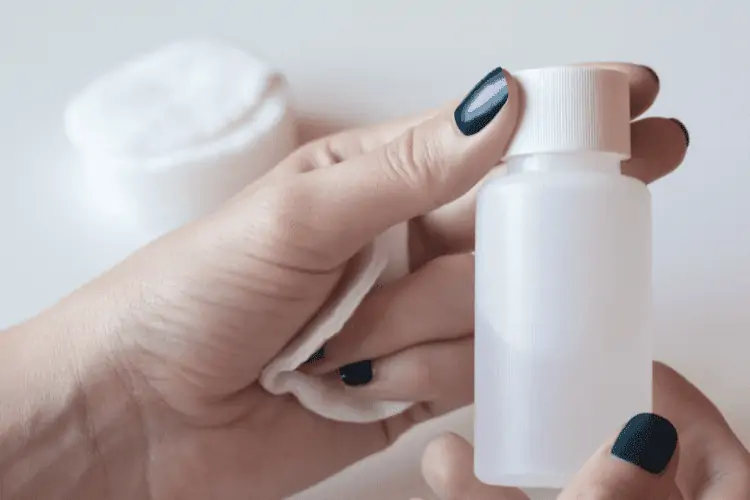
Nail polish remover is a solvent used to dissolve nail polish and is usually made with acetone or similar solvents. To counteract nail polish’s drying effects, nail polish removers contain hydrating ingredients, such as aloe, argan oil, and vitamin E. They are all a liquid consistency and are used by soaking a cotton ball and applying it to the top of the nail.
How to Find the Best Nail Polish Remover
There are many factors that go into choosing the best nail polish remover for you and a few myths that come with nail polish remover. Before deciding what the best nail polish to use is, you must ask yourself a few questions. These questions are:
What Are You Removing?
Removing regular nail polish and other nail enhancement materials is totally different. Regular nail polish is easier to remove, and you can use many kinds of nail polish remover to soak it off. However, other nail enhancements that people commonly remove themselves require acetone nail polish removers, including gel nails, acrylics, and dip nails.
Do You Want Fast or Less Drying Removal?
Unfortunately, I have never found a nail polish remover that is both fast and moisturizing. The quickest way to remove your nail polish is always acetone-based removers, but these can be more drying and eventually cause your nails to become brittle with frequent use.
There are other nail polish removers with less drying ingredients, such as propylene carbonate, but they will take much longer and more scrubbing to remove your polish completely.
Are You Looking For Fewer Chemicals?
I think most people know by now that frequent use of most chemicals on our bodies is not good for you. Sadly, no nail polish remover is 100% natural because nail polish needs a chemical solvent to be removed. However, there are nail polish removers with only one or two chemical ingredients rather than the entire product containing chemicals.
3 Acetone Myths
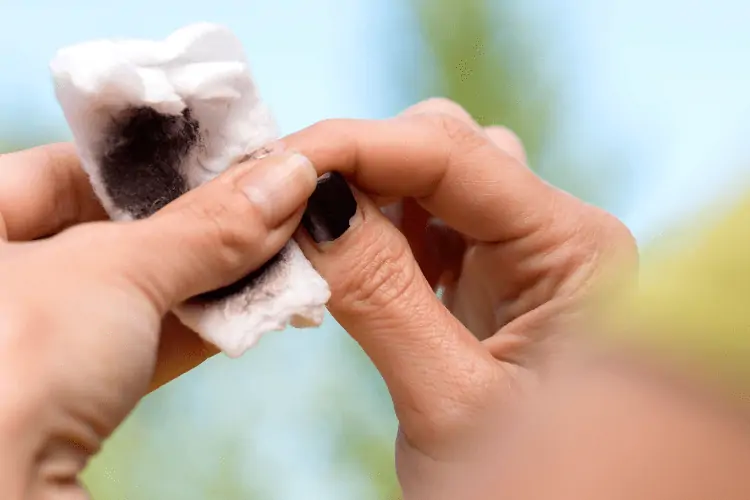
Companies have recently started releasing a lot of acetone-free nail polish removers, giving consumers the idea that there is something wrong with acetone. I know that acetone is not perfect, but it is most certainly not the worst ingredient that you can use. Below you will find a few myths that have been said about acetone and the truth behind it.
Acetone is Harmful
Although acetone dries out your nails and you should not drink it, there is no evidence that it causes serious health issues if used correctly and sparingly. The only people who should be worried about acetone being harmful are nail technicians exposed to it every day because it can make them dizzy or give them headaches.
Acetone is Not Natural
Acetone is actually more natural than other solvents. Even though the acetone in nail polish removers is most likely made through dehydrogenation, you can find it in trees, volcanos, tobacco, and even our bodies.
Acetone Causes Cancer
There is no credible source that states acetone causes cancer. It is actually complicated for acetone to enter your body unless your face is up close or you are drinking it. Acetone evaporates extremely fast, regardless of what the smell makes you think, and it can not penetrate the dermis layer of skin to enter your bloodstream.
Good Alternatives for Acetone
Now that you know the facts about acetone, you should be able to decide what nail polish remover to go for. Even though acetone is not as harmful as people think, it is still a drying chemical that can leave your nails dry with frequent use. If you plan to use nail polish remover more than a couple of times a week, try these alternative nail polish remover active ingredients.
Propylene Carbonate
This is the best acetone substitute because it is less drying, environmentally friendly, and even less toxic. I would use this over acetone for the less drying aspect because it takes quite a bit longer to remove nail polish.
Isopropyl Alcohol
This is an excellent alternative for when you can’t find the acetone because most people have this lying around the house. It is also less drying and less toxic, but it comes from fossil fuels and takes much longer to remove nail polish.
Common Acetone Alternatives to Avoid
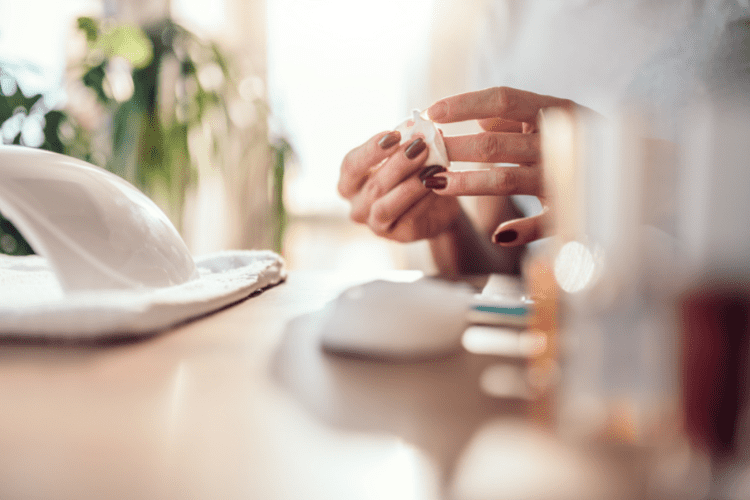
Just because a nail polish remover does not contain acetone does not mean it is good for you. This is a common misconception due to the myths above making acetone seem like the worst thing in the world. Let me tell you, the solvent ingredients listed below are much worse than acetone.
Methylbenzyne
Also known as phenylmethane or toluene, this acetone substitute has been known to cause headaches, nausea, and birth defects in pregnant women. It is also made from fossil fuels, which is not good for environmentally conscious ones.
Ethyl Acetate
This ingredient is most likely where acetone got its cancer-causing myth. Ethyl acetate is a common acetone alternative that has been linked to causing cancer and neurological issues with repeated exposure.
Methanol
Although this ingredient does not have as serious effects, such as cancer or birth defects, it is much more potent in smaller doses. Using this instead of acetone can cause acetone’s extreme side effects, like headaches, nausea, and dizziness, but with much less exposure.
Best Nail Polish Removers
Zoya Remove Plus
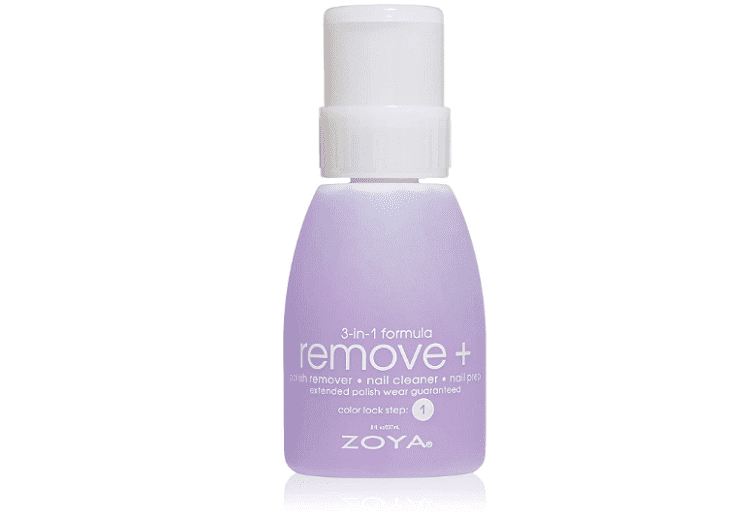
Pros
- Pump top
- Fast removal
- Moisturizing ingredients
- Cruelty-free
Cons
- Pricey
- No natural ingredients
Zoya’s number one nail polish remover is an acetone-based solvent with glycerin to counteract the drying effects. This does a great job of quickly removing any nail polish and even gel polish or acrylics if you have the patience. It also comes packaged in a bottle with a pump top to ensure no spills and the right amount of product is used.
Because Zoya Remove Plus can remove polish quickly while keeping your nails from completely drying out so efficiently, it is a bit pricier, starting at $12 for a small bottle. This nail polish remover has no natural ingredients, including acetone, glycerine, fragrance, and violet coloring, but it is cruelty-free.
Sally Hansen Kwik Off
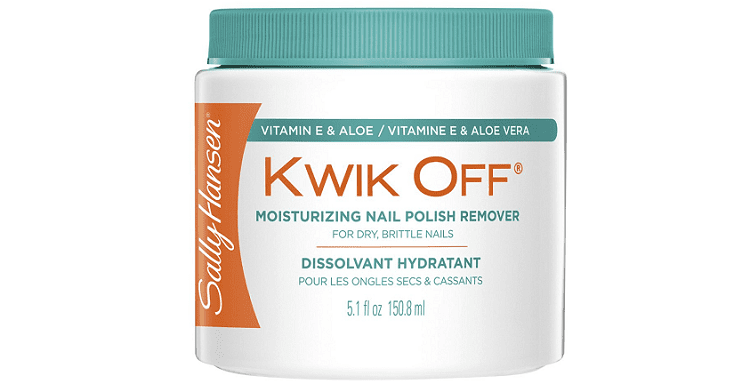
Pros
- Fast removal
- Natural moisturizing ingredients
- Easy wipe sponge included
Cons
- Not cruelty-free
- The sponge inside can get dirty quickly
Sally Hansens Kwik Off is another acetone-based nail polish remover that includes aloe vera to soothe and keep your nails and skin moisturized naturally. Another moisturizing ingredient that they use that I’m not too fond of is lanolin, a moisturizing product produced from sheep, and this ingredient makes the product not cruelty-free.
Another nice thing about this nail polish remover is that it has a sponge inside that you can stick your fingers into to rub off your polish rather than using cotton balls. This aspect helps keep things clean without having to dump nail polish remover all over a cotton ball. However, if you are removing nail polish frequently, the sponge can become dirty fast and eventually be unusable.
Blossom Nail Polish Remover
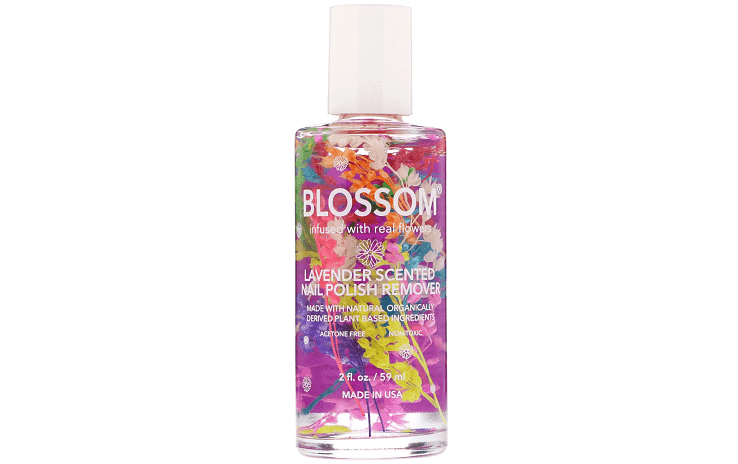
Pros
- Natural, limited ingredients
- Environmentally friendly
- Non-drying
- It can be used to remove polish over acrylics
Cons
- Will only remove regular nail polish
- It takes a bit longer
If you are someone that only uses regular polish, this is the remover for you. The only ingredients in Blossom nail polish remover are propylene carbonate and lavender oil. Propylene carbonate is a recently discovered solvent that works for nail polish and is less drying than acetone. It is also environmentally friendly because it does not use fossil fuels for production like most other acetone alternatives.
The only downside to using this product over an acetone-based nail polish remover is it will take much longer to remove your polish. You should hold a soaked cotton ball on your nail for at least twenty seconds before trying to rub it off. It also will not remove gel or any artificial nails, which can be a good thing if you only want to remove nail polish that you put over acrylics.
Static Nails Polish and Pop On Remover
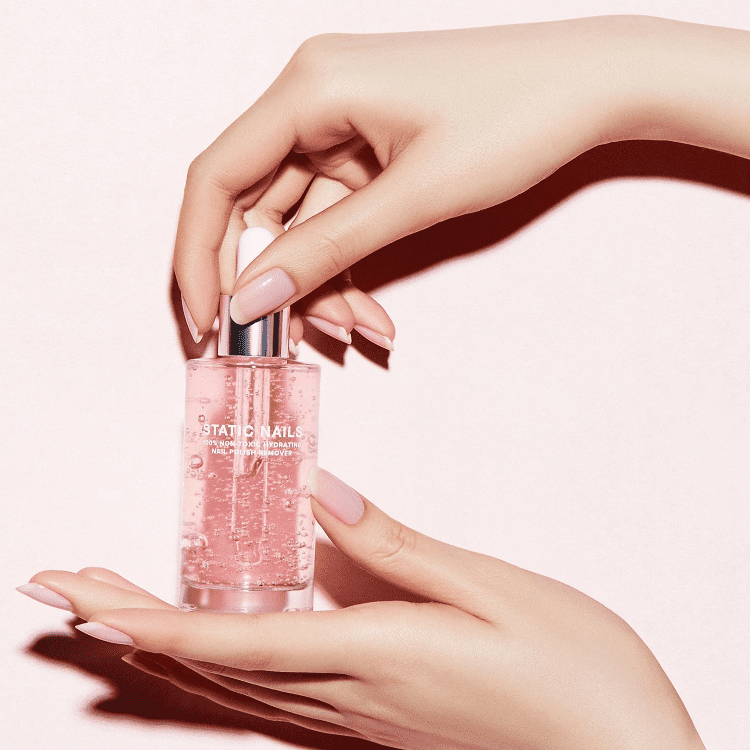
Pros
- Environmentally friendly
- No smell
- Non-drying
- Gel-like consistency
Cons
- Pricey
- Only removes regular polish
Static Nails is another nail polish remover that uses propylene carbonate as its active ingredient, which is a non-smelly, environmentally friendly product that is not made from fossil fuels. This is a moisturizing substitute for acetone, and it has a gel-like consistency instead of a liquid. The nice thing about this one is you can simply place a drop of it on each nail and let it sit for about twenty seconds before buffing it away.
I’m not too fond of this remover because it is way more pricey than all the other removers, with a bottle starting at $24. Although, you do not need to use as much of this to remove your nail polish because of its thicker consistency that sits on the nail better. With this remover, you can not remove gel or artificial nails, but you can remove pop-on nails.
Cutex Care Swipe and Go
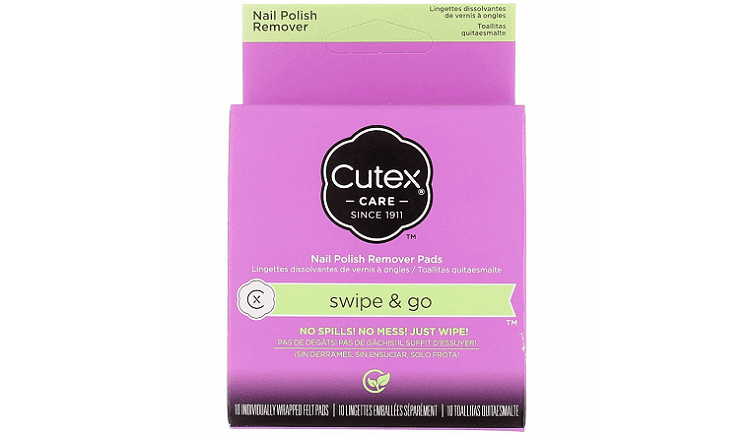
Pros
- Made for on the go removal
- Superfast removal
- Natural moisturizing ingredients
- Cruelty-free and vegan
Cons
- Drying with frequent use
Cutex is a commonly used nail polish remover known for working extremely fast due to its high acetone content. This specific Cutex nail polish remover version is packaged into separate pouches with wipes inside. You can conveniently grab a bag, throw it in your purse and remove your nail polish while you’re going without worrying about spills or cotton balls.
Even though these polish removing pads have naturally moisturizing ingredients, like linseed oil and apricot oil, they can make your nails dry with frequent use because of their high acetone content. I would only keep this around for when your nail polish looks horrible, but you don’t have the time to sit down and adequately remove your polish.
Tips For Using Nail Polish Remover

As I mentioned above, no nail polish remover will be completely safe if not used properly. There are also some standard practices to help make your removal process much more straightforward. For more information on removing nails properly, visit my other article, “How to Remove Nails Guide”.
Make Sure There Is Ventilation
Ventilating your area can be as simple as opening a window or turning on a fan. This helps keep the fumes from sitting around you so that you don’t breathe in too many chemicals or deal with the smells of nail polish removers. Again, using nail polish remover only a couple of times a week is not harmful, but I do not enjoy sitting in a room full of cleaner-like smells.
Let The Remover Sit Before Rubbing
I like to let a cotton ball soaked in nail polish remover sit on my nail for about ten to twenty seconds before rubbing off the polish. This helps the product absorb into the polish and start breaking it down without you having to do much work. Acetone polish removers will work much faster than other nail polish removers and do not need to sit on the nail for as long.
Follow Up With Cuticle Oil
Cuticle oil is crucial in keeping your nails healthy and strong because it moisturizes your nail and surrounding skin. This will counteract any dryness that your nail polish remover may have caused, regardless of what nail polish remover you use. Whether it’s acetone or a less drying remover, you should always use cuticle oil to restore your nail moisture.
FAQs
Answer: The average user of nail polish remover has nothing to worry about. Any nail polish remover you use can be harmful if used in large doses.
Repeated exposure to the chemicals inside nail polish remover can cause dryness in your fingers, headaches, dizziness, nausea, and even cancer with some ingredients. These symptoms only occur if you are around nail polish remover multiple times every day.
Answer: The safest nail polish removers contain the active ingredient propylene carbonate. This is a non-drying, environmentally friendly, and lesser toxic ingredient found in some nail polish removers.
However, it takes much longer to remove nail polish with this ingredient than with other ingredients. Use an acetone nail polish remover for a faster ingredient that should not cause much harm.
Answer: If you ever find yourself without nail polish remover, the best alternative is to use isopropyl alcohol. This is the active ingredient in most household cleaners and is also a solvent. You will need to soak your nails with isopropyl alcohol with a cotton ball for 30 seconds before you start to rub away the nail polish. It will take longer to remove your nail polish than with acetone, but it will get the job done.
Answer: Nail polish removers are made of solvents, which are any substance that dissolves another substance. Nail polish needs a specific solvent to dissolve it, such as acetone, isopropyl alcohol, or propylene carbonate. Some nail polish removers contain other ingredients to help keep your nails moisturized, like almond oil, aloe extract, and vitamins A, C, or E.
Answer: If your nails hurt after using nail polish remover, it is most likely due to your nails being damaged somehow. This could be that they were filed down too much during a nail service, taking away your nail’s safety barrier. If it is not due to a nail service, it could be an underlying health problem that makes your nails brittle, thinner, or rigid.
Final Thoughts
I will always be someone who stands by acetone as a nail polish remover. It’s what we have always used in the nail salon and probably always will because, well, it works!
I have tried many different nail polish removers at home, and I always circle back to using acetone because it works so much better. I’ve never noticed a difference in dryness between non-acetone removers and using cuticle oil after removing with acetone.
One product I have not used yet because it is a newer remover that isn’t widespread yet is propylene carbonate removers. I am actually very excited to try one of those out because they are an environmentally friendly alternative that does not smell. I also love that each propylene carbonate product mentioned above has minimal ingredients, making them great for everyone.
Continue reading:
Best Nail Polish Holders Guide
Best Nail Polish Organizers Guide: 14 Storage Options to Reduce Clutter

